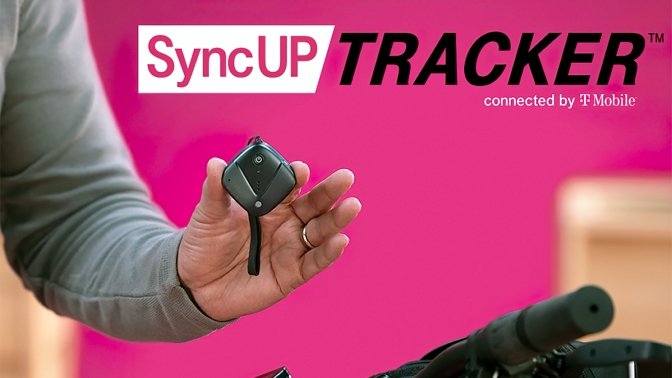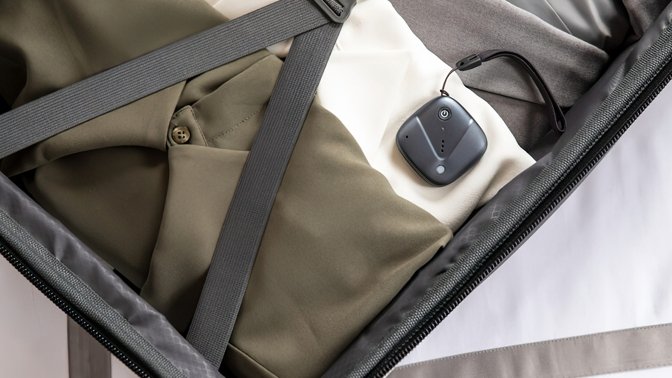Taking on AirTag, T-Mobile's SyncUp Tracker has LTE, seven days of battery
Hot on the heels of Apple's AirTag announcement, T-Mobile is launching the SyncUp Tracker, which uses LTE and GPS instead of Bluetooth or ultra-wideband (UWB) for locating lost items.

T-Mobile's SyncUp tracker uses LTE instead of Bluetooth or UWB
Like AirTag and Tile, customers can attach the SyncUp Tracker to items such as luggage, keys, bikes, wallets, or pets' collars. If users lose the item, they can attempt to locate it through a corresponding iOS app.
T-Mobile's $60 lost-item tracker works with the SyncUp app, which will be available for free on the App Store.
While Apple's AirTag doesn't have a built-in cellular connection, it can tap into Apple's Find My network when the tracker is out of reach of the user's iPhone. This method calls upon any nearby Apple devices to transmit the AirTag's location data.
Apple's approach temporarily employs strangers' devices when out of reach. However, the method doesn't use detectable amounts of mobile data, and it encrypts user data fully.
SyncUp's built-in LTE may not provide any significant advantages over AirTag's approach for people who would only misplace their items in populated areas. However, for those who visit remote spots unlikely to have any nearby iPhone users, an LTE-enabled tracker could prove beneficial.
One significant downside to T-Mobile's tracker is that its cellular capabilities mean it requires regular charging. The carrier says the tracker's battery can last "up to seven days on a single charge." Apple says AirTag's replaceable battery can maintain power for more than a year, allowing owners to attach it to an item and forget about it.
Although T-Mobile hasn't provided a complete spec list, the SyncUp device also appears significantly thicker than non-cellular trackers like AirTag and Tile.
Both trackers have IP67 water and dust resistance.

T-Mobile's tracker costs $60 and launches on May 7
SyncUp users can also set up virtual geofenced boundaries. If set up, the app will notify the user when the tracker leaves a designated area. The tracker can sound a ringtone to help users find it when nearby. It also has customizable profiles and a light sensor that can optionally notify the user's phone when moved out of dark storage areas like a locker or backpack.
"SyncUP TRACKER brings peace of mind to customer's most prized possessions and valuables, which is why we're putting the power of our network behind it," said Matt Staneff, T-Mobile's Marketing Officer. "From families to cars to now things, T-Mobile's network is connecting just about anything - because it has the power and reliability customers can depend on."
T-Mobile has previously used the SyncUp brand name with SyncUp Drive, an LTE hotspot for cars that can also display the connected automobile's data.
The SyncUp Tracker launches on May 7 at T-Mobile retail stores and online. Eligible customers will be able to purchase the SyncUp Tracker either at the full retail price or on a 24-month installment plan.
Stay on top of all Apple news right from your HomePod. Say, "Hey, Siri, play AppleInsider," and you'll get latest AppleInsider Podcast. Or ask your HomePod mini for "AppleInsider Daily" instead and you'll hear a fast update direct from our news team. And, if you're interested in Apple-centric home automation, say "Hey, Siri, play HomeKit Insider," and you'll be listening to our newest specialized podcast in moments.

T-Mobile's SyncUp tracker uses LTE instead of Bluetooth or UWB
Like AirTag and Tile, customers can attach the SyncUp Tracker to items such as luggage, keys, bikes, wallets, or pets' collars. If users lose the item, they can attempt to locate it through a corresponding iOS app.
T-Mobile's $60 lost-item tracker works with the SyncUp app, which will be available for free on the App Store.
While Apple's AirTag doesn't have a built-in cellular connection, it can tap into Apple's Find My network when the tracker is out of reach of the user's iPhone. This method calls upon any nearby Apple devices to transmit the AirTag's location data.
Apple's approach temporarily employs strangers' devices when out of reach. However, the method doesn't use detectable amounts of mobile data, and it encrypts user data fully.
SyncUp's built-in LTE may not provide any significant advantages over AirTag's approach for people who would only misplace their items in populated areas. However, for those who visit remote spots unlikely to have any nearby iPhone users, an LTE-enabled tracker could prove beneficial.
One significant downside to T-Mobile's tracker is that its cellular capabilities mean it requires regular charging. The carrier says the tracker's battery can last "up to seven days on a single charge." Apple says AirTag's replaceable battery can maintain power for more than a year, allowing owners to attach it to an item and forget about it.
Although T-Mobile hasn't provided a complete spec list, the SyncUp device also appears significantly thicker than non-cellular trackers like AirTag and Tile.
Both trackers have IP67 water and dust resistance.

T-Mobile's tracker costs $60 and launches on May 7
SyncUp users can also set up virtual geofenced boundaries. If set up, the app will notify the user when the tracker leaves a designated area. The tracker can sound a ringtone to help users find it when nearby. It also has customizable profiles and a light sensor that can optionally notify the user's phone when moved out of dark storage areas like a locker or backpack.
"SyncUP TRACKER brings peace of mind to customer's most prized possessions and valuables, which is why we're putting the power of our network behind it," said Matt Staneff, T-Mobile's Marketing Officer. "From families to cars to now things, T-Mobile's network is connecting just about anything - because it has the power and reliability customers can depend on."
T-Mobile has previously used the SyncUp brand name with SyncUp Drive, an LTE hotspot for cars that can also display the connected automobile's data.
The SyncUp Tracker launches on May 7 at T-Mobile retail stores and online. Eligible customers will be able to purchase the SyncUp Tracker either at the full retail price or on a 24-month installment plan.
Stay on top of all Apple news right from your HomePod. Say, "Hey, Siri, play AppleInsider," and you'll get latest AppleInsider Podcast. Or ask your HomePod mini for "AppleInsider Daily" instead and you'll hear a fast update direct from our news team. And, if you're interested in Apple-centric home automation, say "Hey, Siri, play HomeKit Insider," and you'll be listening to our newest specialized podcast in moments.

Comments
"up to seven days on a single charge."
I’m betting these will be more of a gag gift and given away to customers.
/s
I'm fine with Tile and Apple's thing - they seem to have a good balance of price, convenience, and privacy - but as of yet I am not biting on that either.
A spot remote enough to have no nearby iPhones isn't likely to have cell coverage either.
These would be killer if Apple ever released AirPower.
I WILL forget to charge (all of!) my trackers regularly - and when I loose something it WILL have a dead battery.
Apple’s take on this has a clear focus. And that focus is precisely where it needs to be: no need for charging.
I’m sure they looked at all the options. It seems to me they made the right choice in relation to the technology and its capabilities.
Of course there are the malicious uses as well. Tracking someone unknowingly is the most obvious.
I would use one of these on my FPV quad copters to locate it in case it went down out of line of site. Everywhere I've flown has good cellular service for Verizon, AT&T & T-Mobile. However, I can fly over wooded areas, large fields, etc. Not so easy to find an 8" x 8" quad in the woods or field, when you are not sure where it went down.
Many vehicles on the market already do have GPS tracking and LTE communication, and have for years, so I don't see why an Apple car wouldn't - and would probably do it way more securely. lol My 2019 Jeep Grand Cherokee has this, and I can track it via an app. I can also use the app to get telemetry (tire pressures, oil life, fuel level, odometer) and do things like lock/unlock and remote-start. The tracking and remote functions were free for the first year, but I didn't bother to renew it.